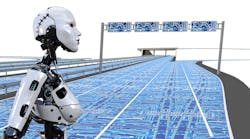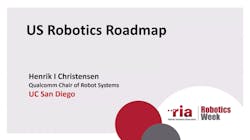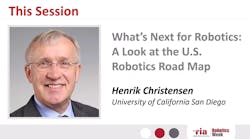Henrik Christensen, director of the Contextual Robotics Institute at the University of California San Diego, gave a presentation on the newest (and fourth edition) A Roadmap for US Robotics during the RIA Robotics Week. This 90-page document is published every four years and was released on Sept. 9. It details different applications and growth areas for the robotics industry, as well as societal drivers, obstacles and how to address those obstacles. The report was created from research papers from robotics experts and various workshops.
Christensen described some major trends covered in the report, including post-COVID society, changing trade dynamics, mass customization, urbanization and an aging society.
“My long-term vision, of course, is a UPS truck driving along in your neighborhood with an advanced 3D printer in the back that will do all of the manufacturing on its way to you,” he said.
According to Christensen, the increase in urbanization will hinder logistics and transportation. However, it will create an environment suitable for more drone-based delivery and emergency response systems.
“There are no robots in emerging technologies anymore,” said Christensen. “It is AI that is the new emerging technology.”
He said that does not mean advancements aren’t being made. New materials are now allowing for the development of safer robots and custom 3D-printed components. Progression in LIDAR and other sensors, especially in smartphone manufacturing, is changing the way we think about robotics. Advancements in computer architectures can lend a hand to robotics systems through closed-loop processes and edge computing.
“All of this opens up for entirely new computing architectures,” Christensen noted. “It also implies that we can now think about IoT and how we can embed IoT into the future of building robotic systems.”
COVID has changed the world of robot manufacturing forever, and some of those large segments of change in the report are in logistics, food and disinfection, three industry segments highlighted in an earlier RIA Robotics Week panel.
“If you had asked me a year ago and said ‘Is there a big market for disinfection robots?’ I would have said ‘I don’t think so,’” said Christensen. “But now? The future cruise ships, elementary schools, grocery stores and, of course, hospitals are all going to look to robotics.”


